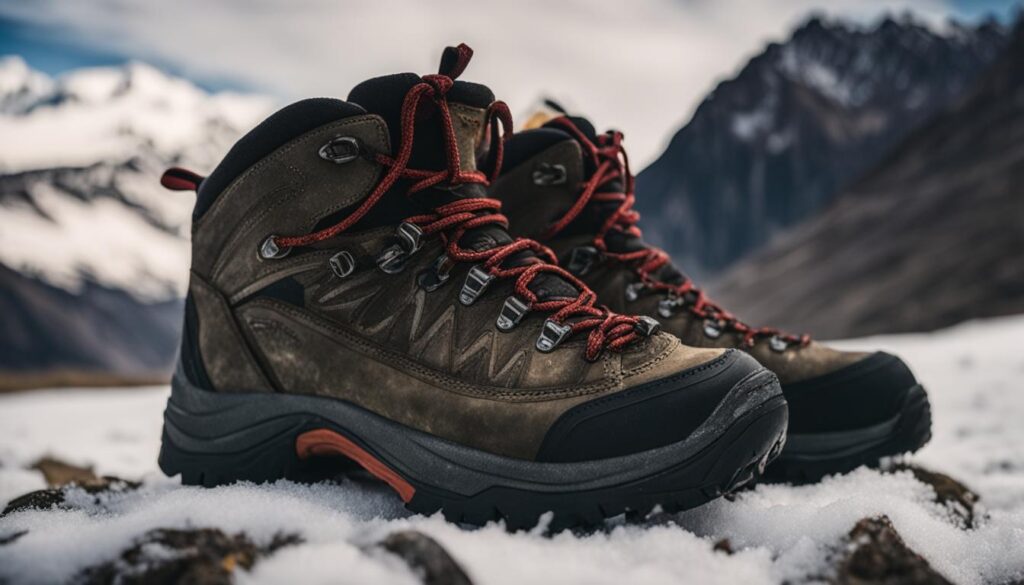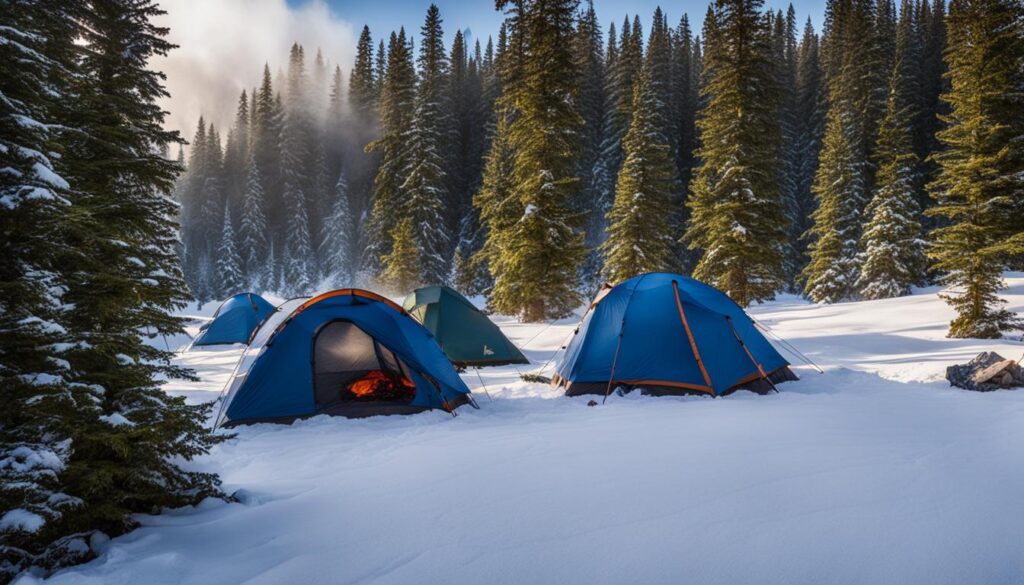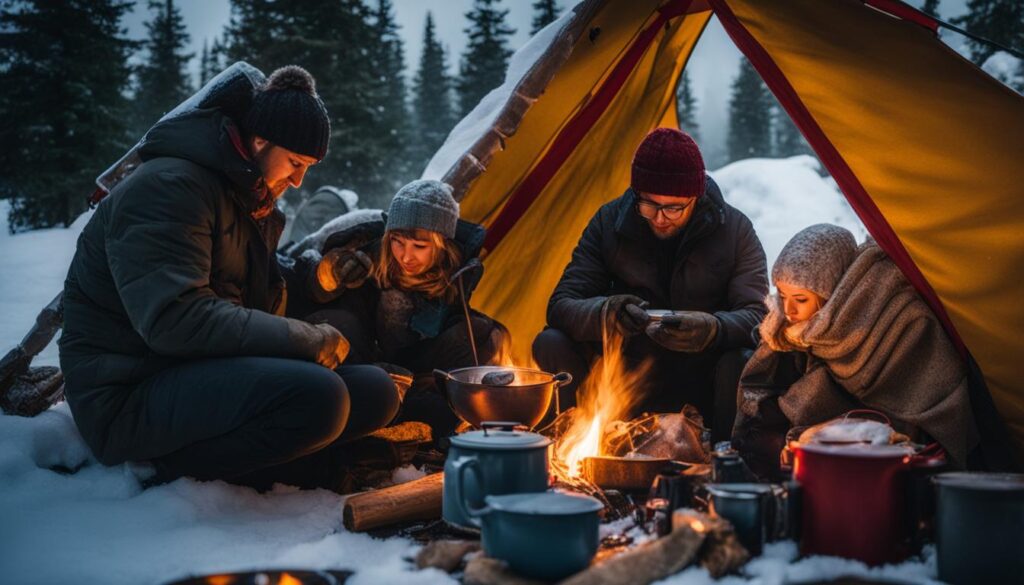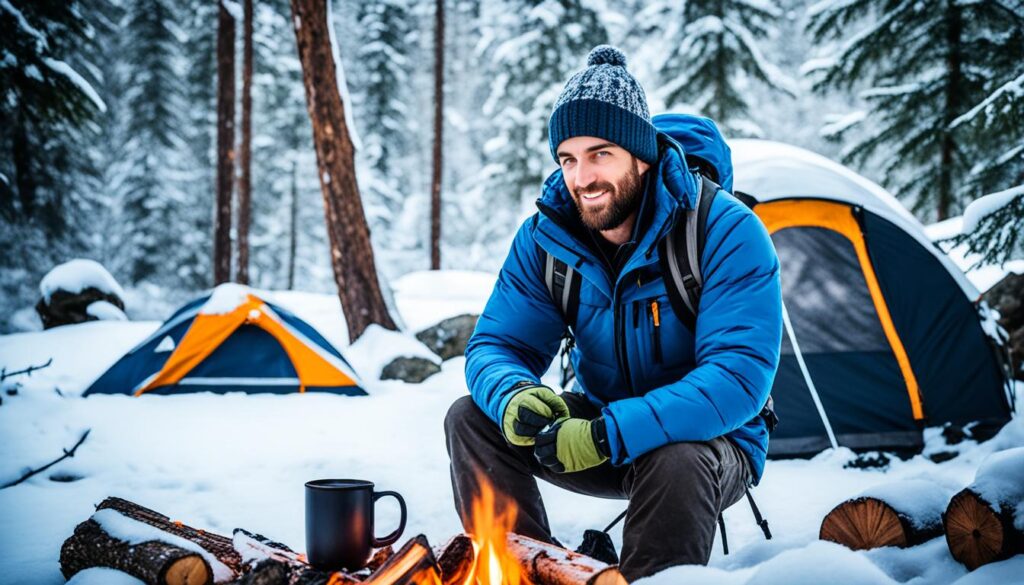When planning a winter camping trip, it’s important to be prepared for the cold weather and know how to stay warm and comfortable. Camping in freezing temperatures can be a great adventure, but it requires some extra precautions to ensure your safety and enjoyment. In this article, I will provide you with essential tips and tricks for staying warm during your winter camping adventures.
Key Takeaways:
- Dress in layers and use a proper sleeping bag to insulate yourself from the cold.
- Choose a winter tent and campsite that are designed to withstand freezing temperatures.
- Manage moisture and condensation to prevent discomfort and cold.
- Stay hydrated and nourished to generate heat and keep your energy levels up.
- Practice fire safety and consider using a camp stove for cooking.
Contents
Layering for Warmth: Clothing and Sleeping Bag
When it comes to winter camping, proper layering is crucial for staying warm in cold weather. Layering allows you to adjust your clothing to the changing temperatures throughout the day, ensuring optimum comfort and insulation.
Start with a base layer that is moisture-wicking and will keep you dry. Look for materials like merino wool or synthetic fibers that are soft, comfortable, and retain warmth even when wet. A good base layer helps regulate your body temperature by wicking sweat away from your skin.
Next, add an insulation layer to trap warm air close to your body. This layer can be a fleece jacket, down or synthetic insulated vest, or a thermal sweater. Insulation layers are designed to provide warmth without adding bulk, allowing for freedom of movement.
For your outer layer, choose a waterproof and windproof jacket or parka to protect you from the elements. Look for features like sealed seams, adjustable hoods, and cuffs to keep the cold air out. This layer acts as a barrier against rain, wind, and snow, keeping you dry and warm.
Dressing Tips:
- Layering is all about versatility. Add or remove layers as needed to regulate your body temperature.
- Choose clothing that is lightweight and breathable to prevent overheating.
- Avoid cotton as it absorbs moisture and takes longer to dry, increasing the risk of hypothermia.
- Don’t forget to layer up your lower body too. Wear thermal leggings or long underwear under your pants for extra insulation.
Now that we’ve covered clothing layering, let’s not forget about the most important piece of gear for staying warm at night – your sleeping bag. Layering up your sleeping bag can provide that extra warmth you need in freezing temperatures.
Consider using an extra sleeping bag liner made of fleece or thermal material. This liner acts as an additional barrier between you and the cold ground, providing extra insulation and heat retention. It also helps keep your sleeping bag clean and extends its lifespan.
Remember, layering is not just about piling on clothes. It’s about using the right combination of base, insulation, and outer layers to create a thermal barrier that keeps you warm and comfortable. By following these layering techniques for both your clothing and sleeping bag, you’ll be well-equipped for a cozy and enjoyable winter camping experience.

Choosing the Right Tent and Campsite
When planning a winter camping trip, one of the most important considerations is selecting the right tent and campsite. Your tent will be your shelter from freezing temperatures, while your campsite location can significantly impact your comfort and safety. Here are some key factors to keep in mind:
Tent Selection
Choosing a tent specifically designed for winter conditions is crucial. Look for tents that offer good insulation and are capable of withstanding freezing temperatures and strong winds. These tents are often made with a sturdy frame, reinforced poles, and durable fabric that can handle snow loading. Additionally, consider a four-season tent with a double-walled construction for increased warmth and protection.
Location and Shelter
When setting up your winter campsite, it’s important to find a location that offers shelter from the elements. Look for spots that are shielded from wind, such as areas with natural windbreaks like trees or rock formations. Avoid setting up camp in low-lying areas where cold air tends to accumulate. Additionally, be aware of the potential avalanche danger and choose a campsite away from avalanche-prone slopes.
To provide additional insulation and shield your tent from drafts, pack down the snow where you plan to set up your tent. This creates a solid foundation and helps prevent cold air from seeping into your sleeping area. Building a snow wall around your tent can further enhance insulation and provide an extra barrier against wind.

Sleeping Area Preparation
In addition to selecting the right tent and campsite, preparing your sleeping area properly is essential for staying warm during winter camping. Use a groundsheet or tent footprint to insulate your tent floor and prevent moisture from seeping in. A foam or inflatable sleeping pad provides insulation and cushioning, while a cold-weather sleeping bag with a lower temperature rating ensures you stay warm throughout the night.
Consider layering your sleeping arrangements by using an additional sleeping bag liner or a thermal blanket inside your sleeping bag. This extra layer adds insulation and can make a significant difference in keeping you cozy during freezing nights.
By choosing the right tent and campsite, as well as properly preparing your sleeping area, you can greatly enhance your comfort and safety while winter camping in freezing temperatures.
Managing Moisture and Condensation
Moisture and condensation can quickly make camping in winter uncomfortable and cold. To ensure a warm and cozy experience, it’s important to manage moisture effectively. Here are some tips to help you stay dry and warm during your winter camping adventures.
Proper Ventilation
One of the key ways to prevent condensation inside your tent is by ensuring proper ventilation. Partially open the vents or doors of your tent to allow air to circulate, reducing the buildup of moisture. This will also help regulate the temperature inside the tent, preventing excessive humidity.
Separate Wet Items
Avoid bringing wet items, such as damp clothes or snow-covered gear, into your sleeping bag. Moisture from these items can seep into your sleeping bag, making you cold throughout the night. Instead, store wet items in a separate area of your tent or hang them outside to dry.
Balaclava for Breath Control
Condensation from your breath can lead to dampness inside your sleeping bag. To prevent this, consider wearing a balaclava or a scarf that covers your mouth and nose while sleeping. This helps to redirect your breath away from your sleeping bag, reducing the chances of condensation buildup.
By following these moisture management tips, you can create a comfortable and dry camping environment, ensuring you stay warm in winter camping conditions.

Moisture Management Checklist
| Tip | Description |
|---|---|
| Proper Ventilation | Partially open tent vents or doors to allow air circulation |
| Separate Wet Items | Store wet items separately to prevent moisture from seeping into sleeping bag |
| Balaclava for Breath Control | Wear a balaclava or scarf to prevent breath condensation inside sleeping bag |
Staying Hydrated and Nourished
When embarking on a winter camping adventure, it’s essential to prioritize staying hydrated and nourished. Camping in freezing temperatures can be physically demanding, and maintaining your body’s health and energy levels is crucial for staying warm and enjoying your winter camping experience.
First and foremost, make sure to drink plenty of water throughout the day, even if you don’t feel thirsty. Cold weather can lead to increased dehydration due to elevated urine production and respiratory water loss. By staying well-hydrated, you can help regulate your body temperature and prevent discomfort.
To fuel your body and generate heat, it’s important to consume high-calorie meals and snacks during winter camping. Your body burns more calories in cold weather as it works harder to keep warm. Pack nutrient-dense foods such as trail mix, energy bars, jerky, and dried fruits. These snacks are not only lightweight and easy to carry, but they also provide a quick source of energy.
“Proper nutrition plays a vital role in maintaining body warmth during winter camping. Ensure you consume meals rich in carbohydrates, healthy fats, and protein to provide the necessary fuel for your outdoor activities.”
Packing hot drinks is also a smart way to keep warm and nourished during cold weather camping. Consider bringing a thermos filled with hot water, tea, or hot chocolate. These beverages will not only warm you up but also provide a comforting touch to your camping experience.
Here are some additional winter camping tips to help you stay hydrated and nourished:
- Carry a variety of snacks that provide both instant energy and sustained fuel, such as nuts, cheese, and granola bars.
- Opt for dehydrated meals that are easy to prepare and require minimal clean-up.
- Include warm soups and stews in your camping menu to warm you from the inside out.
- Use a portable water filter or water purifying tablets to ensure a safe and clean water supply during your winter camping trip.
Remember, proper hydration and nutrition are vital for camping in freezing temperatures. By taking care of your body’s needs, you’ll enhance your comfort, endurance, and overall enjoyment of winter camping.
| Benefits of Proper Hydration and Nutrition in Winter Camping | Importance |
|---|---|
| Regulates body temperature | Prevent hypothermia and frostbite |
| Provides energy for physical activities | Enhances endurance and stamina |
| Boosts immune system | Helps fight off colds and illnesses |
| Improves mental clarity and focus | Enhances decision-making abilities |
| Supports muscle recovery | Aids in post-activity muscle repair |
Fire Safety and Winter Cooking
When camping in freezing temperatures, it’s crucial to prioritize fire safety. By following a few winter camping hacks, you can enjoy a warm and delicious meal while minimizing any risks. Remember to use dead downed wood for your campfire, avoiding live trees or branches. This not only ensures a safer fire but also helps preserve the environment.
If you’re camping in an area with fire restrictions, consider using a camp stove instead. Camp stoves are reliable and efficient cooking options that provide consistent heat, even in cold weather. They are compact and easy to use, making them ideal for winter camping trips.
For your meals, try to prepare hot dishes that are easy to cook and clean up. This way, you can minimize your exposure to the cold while still enjoying a warm and satisfying meal. Soups, stews, and one-pot meals are excellent choices for winter camping. They not only provide nourishment but also help to raise your body temperature.
| Fire Safety and Winter Cooking Tips |
|---|
| Use only dead downed wood for campfires. |
| Be mindful of fire restrictions in the area. |
| Consider using a camp stove for cooking. |
| Prepare hot meals that are easy to cook and clean up. |
| Opt for soups, stews, and one-pot meals. |
Remember, safety should always be your top priority when winter camping. By following these tips and practicing fire safety, you can have a memorable and enjoyable outdoor experience.
Additional Tips and Tricks for Staying Warm
When it comes to winter camping, staying warm is essential for a comfortable and enjoyable experience. In addition to the tips mentioned earlier, here are a few extra tricks that can help you stay cozy in cold weather.
One effective way to add warmth to your sleeping bag is by using hand warmers. Simply place them inside your sleeping bag before settling in for the night. The heat generated by the hand warmers will keep you snug and comfortable throughout the night.
Another handy trick is to insulate your water bottles. Fill them with hot water and wrap them in a thick sock or a towel. These insulated water bottles can serve as portable heat sources, providing you with warmth during your winter adventures.
Before going to bed, warm up your core by filling a hot water bottle with hot water and placing it against your body. This simple yet effective method will help keep you warm throughout the night.
Lastly, always be prepared for changing weather conditions and know your limits. Pay close attention to weather forecasts and pack extra layers of clothing, blankets, and cold weather camping essentials to stay prepared. Remember, staying warm is the key to a successful winter camping trip.
FAQ
How can I stay warm when winter camping?
To stay warm when winter camping, it’s important to dress in layers, choose the right tent and campsite, manage moisture and condensation, stay hydrated and nourished, practice fire safety, and try some additional tips and tricks.
What should I wear for winter camping?
When winter camping, it’s essential to layer your clothing. Start with a base layer made of moisture-wicking material, followed by an insulation layer for warmth, and a waterproof, windproof outer layer. Don’t forget to layer up your sleeping bag as well, with an extra sleeping bag liner for added warmth.
How do I choose the right tent and campsite for winter camping?
When camping in freezing temperatures, it’s crucial to choose a tent that is designed for winter conditions and offers good insulation. Set up your tent in a sheltered spot, away from wind and potential avalanche danger. You can also pack down the snow and build a snow wall around your tent for additional insulation.
How do I manage moisture and condensation while winter camping?
To prevent moisture and condensation from making you feel cold and uncomfortable, ensure proper ventilation in your tent by partially opening vents or doors. Avoid bringing wet items into your sleeping bag and store them separately. Using a balaclava can also help keep your breath from condensing inside your sleeping bag.
How can I stay hydrated and nourished during winter camping?
Staying hydrated and nourished is crucial for keeping warm during winter camping. Drink plenty of water throughout the day, even if you don’t feel thirsty. Eat high-calorie meals and snacks to fuel your body and generate heat. Pack hot drinks and quick snacks to keep you warm and energized during outdoor activities.
How can I practice fire safety and cook in the winter while camping?
When camping in winter, it’s important to use dead downed wood for your campfire and be mindful of any fire restrictions in the area. Consider using a camp stove for cooking instead of relying solely on a fire. Prepare hot meals that are easy to cook and clean up, minimizing exposure to the cold.
Any additional tips and tricks for staying warm during winter camping?
Yes! You can use hand warmers inside your sleeping bag for added warmth, insulate your water bottles to turn them into portable heat sources, warm up your core with hot water bottles before bed, and always be prepared for changing weather conditions and know your limits.






